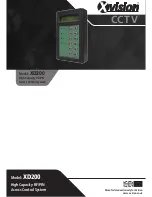Chapter 25 FlexPWM
MPC5602P Microcontroller Reference Manual, Rev. 4
Freescale Semiconductor
693
signal from submodule 0, the Local Sync signal, the Master Sync signal from submodule 0, or the
EXT_FORCE signal from on or off chip depending on the device architecture. The local signals are used
when the user wants to change the signals on the output pins of the submodule without regard for
synchronization with other submodules. However, if it is required that all signals on all submodule outputs
change at the same time, the Master signals or EXT_FORCE signal should be selected.
illustrates the Force logic. The SELA and SELB fields each choose from one of four signals
that can be supplied to the submodule outputs: the PWM signal, the inverted PWM signal, a binary level
specified by software via the OUTA and OUTB bits. The selection can be determined ahead of time and,
when a FORCE_OUT event occurs, these values are presented to the signal selection mux, which
immediately switches the requested signal to the output of the mux for further processing downstream.
Figure 25-41. Force out logic
The local Force signal of submodule 0 can be broadcast as the Master Force signal to other submodules.
This feature allows the local FORCE bit of submodule 0 to synchronously update all of the submodule
outputs at the same time. The EXT_FORCE signal originates from outside the PWM module from a source
such as a timer or digital comparators in the analog-to-digital converter.
0
1
2
3
4
5
6
7
OUTB
PWMB
to Deadtime
logic
D
Q
SELB
Local Force
Master Force
EXT_FORCE
Reserved
FORCE_SEL
OUTA
PWMA
D
Q
Master Force
(from submod0
only)
FORCE_OUT
PWMA
PWMB
from generation h/w
from generation h/w
SELA
DBLPWM
3
2
0
1
Local Reload
Local Sync
Master Reload
Master Sync
0
1
2
3


















